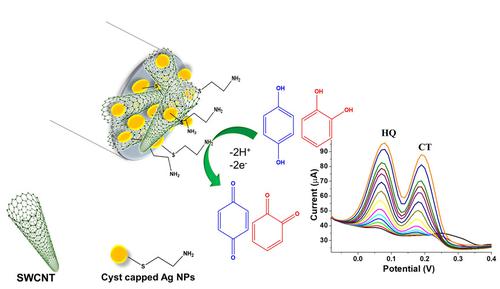当前位置:
X-MOL 学术
›
Electroanalysis
›
论文详情
Our official English website, www.x-mol.net, welcomes your
feedback! (Note: you will need to create a separate account there.)
Cysteamine Capped Silver Nanoparticles and Single-Walled Carbon Nanotubes Composite Coated on Glassy Carbon Electrode for Simultaneous Analysis of Hydroquinone and Catechol
Electroanalysis ( IF 2.7 ) Pub Date : 2018-02-27 , DOI: 10.1002/elan.201700704 Nutthaya Butwong 1 , Supalax Srijaranai 2 , Jeremy D. Glennon 3 , John H. T. Luong 3
Electroanalysis ( IF 2.7 ) Pub Date : 2018-02-27 , DOI: 10.1002/elan.201700704 Nutthaya Butwong 1 , Supalax Srijaranai 2 , Jeremy D. Glennon 3 , John H. T. Luong 3
Affiliation

|
A stable complex of silver nanoparticles (Ag NPs) capped by cysteamine (Cst) together with single-walled carbon nanotube (CNTs) was used to modify a glassy carbon electrode (GCE) for simultaneous detection of hydroquinone (HQ) and catechol (CT). The resulting electrode (AgCst-CNTs/GCE) showed excellent electrocatalysis and reversibility towards this electroactive pair. The peak separations of their oxidation-reduction peaks decreased significantly, compared with those of the unmodified GCE. The signal responses of the AgCst-CNTs/GCE were 5-fold higher while its peak potential separation remained unchanged (ca. 130 mV), compared to the CNTs-modified GCE. The oxidation peak currents obtained for HQ and CT exhibited linearly from submicromolar to hundred micromolar concentrations without any cross-interference. The modified electrode possessed a very large active surface area with a detection limit (S/N=3) of 10 and 40 nM for HQ and CT, respectively. The sensor was demonstrated for the analysis of river water and topical cream as evinced by high accuracy and reproducibility.
中文翻译:

半胱胺封端的银纳米颗粒和单壁碳纳米管复合包覆在玻碳电极上用于同时分析对苯二酚和邻苯二酚
由半胱胺 (Cst) 包覆的银纳米粒子 (Ag NPs) 与单壁碳纳米管 (CNT) 的稳定复合物用于修饰玻碳电极 (GCE),用于同时检测对苯二酚 (HQ) 和儿茶酚 (CT) . 所得电极(AgCst-CNTs/GCE)对这种电活性对显示出优异的电催化和可逆性。与未修饰的 GCE 相比,它们的氧化还原峰的峰间距显着降低。与 CNTs 修饰的 GCE 相比,AgCst-CNTs/GCE 的信号响应高 5 倍,而其峰值电位分离保持不变(约 130 mV)。HQ 和 CT 获得的氧化峰值电流从亚微摩尔浓度到百微摩尔浓度呈线性显示,没有任何交叉干扰。修饰电极具有非常大的活性表面积,HQ 和 CT 的检测限 (S/N=3) 分别为 10 和 40 nM。该传感器已被证明可用于分析河水和外用乳膏,其准确性和重现性证明了这一点。
更新日期:2018-02-27
中文翻译:

半胱胺封端的银纳米颗粒和单壁碳纳米管复合包覆在玻碳电极上用于同时分析对苯二酚和邻苯二酚
由半胱胺 (Cst) 包覆的银纳米粒子 (Ag NPs) 与单壁碳纳米管 (CNT) 的稳定复合物用于修饰玻碳电极 (GCE),用于同时检测对苯二酚 (HQ) 和儿茶酚 (CT) . 所得电极(AgCst-CNTs/GCE)对这种电活性对显示出优异的电催化和可逆性。与未修饰的 GCE 相比,它们的氧化还原峰的峰间距显着降低。与 CNTs 修饰的 GCE 相比,AgCst-CNTs/GCE 的信号响应高 5 倍,而其峰值电位分离保持不变(约 130 mV)。HQ 和 CT 获得的氧化峰值电流从亚微摩尔浓度到百微摩尔浓度呈线性显示,没有任何交叉干扰。修饰电极具有非常大的活性表面积,HQ 和 CT 的检测限 (S/N=3) 分别为 10 和 40 nM。该传感器已被证明可用于分析河水和外用乳膏,其准确性和重现性证明了这一点。











































 京公网安备 11010802027423号
京公网安备 11010802027423号